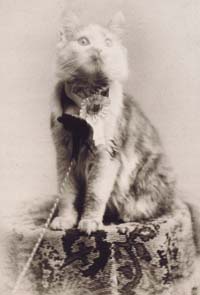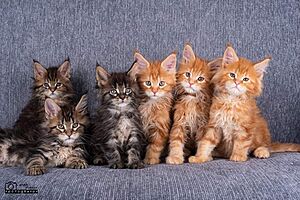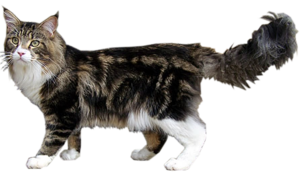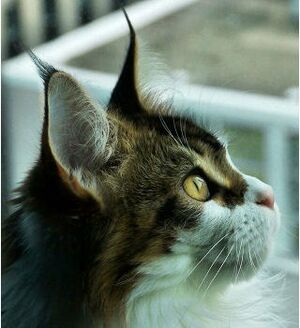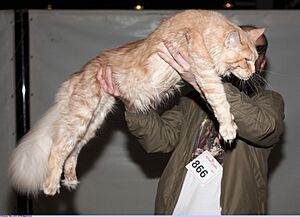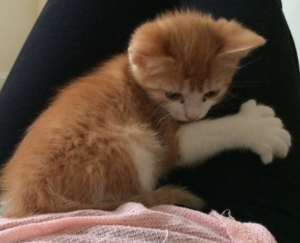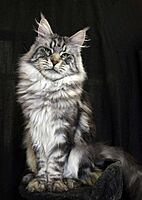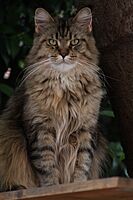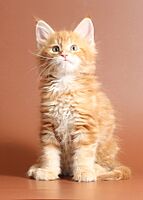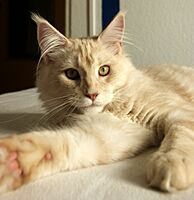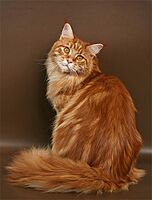Maine Coon facts for kids
Quick facts for kids Maine Coon |
|
|---|---|

A Maine Coon cat
|
|
| Other names | Coon Cat Maine Cat Maine Shag American Longhair American Coon Cat American Forest Cat |
| Common nicknames | Gentle giants |
| Origin | |
| Breed standards | |
| CFA | standard |
| FIFe | standard |
| TICA | standard |
| ACF | standard |
| ACFA/CAA | standard |
| CCA-AFC | standard |
| GCCF | standard |
| Domestic cat (Felis catus) | |
The Maine Coon is a very large domesticated cat breed. It is one of the oldest natural breeds from North America. This special cat breed first appeared in the U.S. state of Maine. Today, it is the official state cat of Maine.
The Maine Coon is known for being big and friendly. This is why people often call them "gentle giants." They are famous for their large size and thick fur coat. This coat helps them stay warm in Maine's cold weather. Many people also say Maine Coons act a lot like dogs.
Maine Coon History
The Maine Coon is one of the biggest domesticated cat breeds. It has a unique look and is a skilled hunter. These cats were very popular in cat shows during the late 1800s. However, their popularity dropped when new long-haired cat breeds came from other countries in the early 1900s. Luckily, the Maine Coon made a big comeback. By 2020, it was the third most popular purebred cat breed in the world.
Where Did Maine Coons Come From?
Old Myths and Stories
Maine Coon cats definitely started in Maine. But how they got there is a bit of a mystery! There are many folk tales and myths about their beginnings.
- One myth says the Maine Coon is a mix of a cat and another animal. Some thought it might be part raccoon or even a bobcat. (But this isn't true, cats and raccoons can't have babies together!)
- Another story suggests these cats are related to Viking ship's cats. These old Viking cats are now known as Norwegian Forest cats.
- A third tale involves Marie Antoinette, who was the Queen of France. Before she was executed in 1793, she tried to escape France. She sent six of her favorite cats, possibly Turkish Angora or Siberian cats, to America on a ship. Even though she didn't make it, her cats safely reached Wiscasset, Maine. There, they supposedly bred with local short-haired cats and became the Maine Coon breed we know today.
What Science Tells Us
For a long time, people thought Maine Coons must be related to other long-haired cats. This was because they looked so similar. Many believed they came from Norwegian or Siberian Forest cats. These cats might have been brought to New England by settlers or Vikings.
However, scientific studies of cat family trees show something different. Maine Coons are part of a group of cats from Western Europe. But they are most closely related to random-bred cats in the Northeastern US, especially around New York. The Norwegian and Siberian Forest cats are also from Western Europe, but they are on a different branch of the family tree.
This means Maine Coons are descendants of cats brought to New England by Puritan settlers in the 1600s and 1700s. Genetically, they are closest to cats found in the United Kingdom. So, they don't look like Norwegian and Siberian Forest cats because they are related. Instead, it's because of something called convergent evolution. This means different breeds developed similar traits because they lived in similar harsh, cold places. Thick, long fur, ear and toe tufts, big bodies, and large, snowshoe-like paws are all helpful traits for surviving in cold climates.
Cat Shows and Popularity
The Maine Coon cat was first mentioned in a book in 1861. Later, in 1903, F.R. Pierce wrote a whole chapter about the breed in Frances Simpson's The Book of the Cat. In the late 1860s, farmers in Maine started telling stories about their cats. They even held a "Maine State Champion Coon Cat" contest at the local Skowhegan Fair.
In 1895, about twelve Maine Coons were shown at a cat show in Boston. On May 8, 1895, the very first North American cat show took place at Madison Square Garden in New York City. A female Maine Coon named Cosey, who was a brown tabby, won "Best in Show." She belonged to Mrs. Fred Brown and received a silver collar and medal. This silver collar was later bought by the Cat Fanciers' Association (CFA) Foundation. It is now kept in their library.
In the early 1900s, the Maine Coon's popularity started to fade. This happened because other long-haired breeds, like the Persian cat from the Middle East, became popular. The last time a Maine Coon won a national cat show for over 40 years was in 1911 in Portland, Oregon. After that, the breed was rarely seen. Some even said it was extinct in the 1950s, but this was not entirely true.
To help the Maine Coon become popular again, the Central Maine Cat Club (CMCC) was started in the early 1950s. Ethylin Whittemore, Alta Smith, and Ruby Dyer created it. For 11 years, the CMCC held cat shows and photo exhibitions. They also wrote the first official breed standards for the Maine Coon.
The Cat Fanciers' Association (CFA) did not accept the Maine Coon as a recognized breed three times. This led to the creation of the Maine Coon Cat Club in 1973. Finally, on May 1, 1975, the CFA gave the Maine Coon "provisional breed status." This meant it could start competing. Then, on May 1, 1976, it was fully approved for championship status.
Over the next few decades, the Maine Coon became very popular. It won many championships and climbed in national rankings. In 1985, the state of Maine officially named the Maine Coon its state cat. By 2012, it was the third most registered cat breed with the CFA.
Maine Coon Characteristics
The Maine Coon is a large and friendly cat. It has a noticeable ruff (a collar of fur) around its chest. It also has strong bones, a powerful jaw, and a rectangular body shape. Its coat has two layers: longer guard hairs over a soft undercoat. They also have a long, bushy tail.
Fur Coat Features
The Maine Coon has long or medium-length fur. The coat is soft and silky, though its texture can change with the fur color. The fur is shorter on their head and shoulders. It gets longer on their stomach and sides. Some cats even have a lion-like ruff around their neck.
Maine Coons don't need as much grooming as other long-haired cats. Their double coat mostly takes care of itself because the undercoat isn't too thick. Their fur changes with the seasons. It's thicker in winter and thinner in summer.
Maine Coons have several special features that help them live in cold, harsh winters.
- Their thick, water-resistant fur is longer on their belly and back legs. This gives them extra protection when they walk or sit on snow or ice.
- Their long, bushy tail looks like a raccoon's tail. It doesn't sink in snow. They can curl it around their face and shoulders to stay warm and protected from wind. They can even curl it under them like a warm cushion when sitting on frozen ground.
- Their large paws help them walk on snow, almost like snowshoes.
- Long tufts of fur grow between their toes. These tufts keep their toes warm and help them walk better on snow.
- Their ears are heavily furred, with extra-long tufts of fur growing inside. This helps keep their ears warm.
Coat Colors and Patterns
Maine Coons can have almost any color that other cats have. However, some colors are not accepted by certain breed standards. These include colors that suggest crossbreeding, like chocolate, lavender, or the pointed patterns seen in Siamese cats. The "ticked" pattern is also sometimes not accepted, but TICA and CFA do allow it. The most common pattern for Maine Coons is brown tabby.
All eye colors are generally accepted. But if a cat is not white, blue eyes or odd-eyes (two different colored eyes) are usually not allowed in shows.
Size and Growth
Before the Savannah cat appeared in the mid-1980s, the Maine Coon was the largest domestic cat breed. It is still the largest non-hybrid (not mixed with a wild cat) breed.
- Male Maine Coons usually weigh from 18 to 22 pounds (8.2 to 10 kg).
- Females usually weigh from 12 to 15 pounds (5.4 to 6.8 kg).
- Adults can be between 10 and 16 inches (25 to 41 cm) tall.
- They can reach a total length of up to 38 inches (97 cm), including their tail.
- Their tail alone can be up to 14 inches (36 cm) long. It is long, tapers (gets thinner towards the end), and is very bushy, much like a raccoon's tail.
Maine Coons have strong, muscular bodies to support their weight. They also have a broad chest. They grow slowly and don't reach their full size until they are three to five years old. Most other cats are fully grown by one year old.
In 2010, the Guinness World Records recognized a male Maine Coon named "Stewie" as the "Longest Cat." He measured 48.5 inches (123 cm) from his nose to the tip of his tail. Stewie passed away in 2013 at age 8. As of 2015, the record for "Longest Cat" is held by "Ludo," who measures 46.59 inches (118.3 cm). Ludo lives in Wakefield, England.
Large Maine Coons can be as long as Eurasian lynxes. However, lynxes are much heavier and taller.
Polydactylism (Extra Toes)
Many of the first Maine Coon cats in New England had a special trait called polydactylism. This means they had one or more extra toes on their paws. When interest in the breed grew again in the 1970s, more Maine Coons seemed to have extra toes compared to other breeds.
However, cat show breeders were told that this trait was not wanted. Kittens with extra toes were often sold as regular pets. Later, some organizations, like The International Cat Association (TICA), started to recognize polydactylism separately. Now, in more and more cat competitions, having extra toes is not seen as a fault.
Polydactylism is rarely seen in show Maine Coons because it was once an automatic reason for disqualification. The gene for polydactylism is a simple dominant gene. This means it's easily passed down. Because it was a disqualifier in shows, breeders tried to remove it from the breed. However, some private groups and breeders now work to keep polydactylism in Maine Coon cats.
Maine Coon Health
Life Expectancy
A study in Sweden (2003–2006) found that Maine Coons live for more than 12.5 years on average. About 74% lived to be 10 years or older, and 54% lived to be 12.5 years or older. A study in England found their life expectancy to be around 11 years.
Heart Health
Hypertrophic cardiomyopathy (HCM) is a heart condition that has been seen in Maine Coons. It makes the heart muscle thicker. A specific gene change found in Maine Coons has been linked to HCM.
About one-third of Maine Coons tested for this gene change at Washington State University tested positive. However, not all cats with the gene will show signs of the disease. Also, some Maine Coons with HCM do not have this specific gene change. This suggests there might be another gene change in the breed that causes HCM. Things like fast growth, large body size, and being overweight might also affect how the disease develops in cats with the gene.
Kidney Health
Polycystic kidney disease (PKD) is an inherited condition where many cysts (small sacs of fluid) form in the kidneys. These cysts are present from birth. They start very small but grow over time. Eventually, they can harm kidney function and lead to kidney failure.
While kidney cysts are sometimes seen in Maine Coons, PKD in this breed seems different from PKD in other breeds like Persians. In a recent 8-year study, only 7 out of 187 healthy Maine Coons had kidney cysts. These cysts were usually single, on one side, small (about 3.6 mm), and in a different location than those seen in Persian cats. Also, all six Maine Coons with kidney cysts in this study tested negative for the PKD1 gene change, which causes PKD in Persians. This shows that the kidney issues in Maine Coons are not the same as the PKD found in Persian cats.
Bone, Joint, and Muscle Health
Hip dysplasia is a problem with the hip joint. It can cause limping and arthritis. This condition is more common in larger, big-boned breeds like Persians and Maine Coons, especially males. Because cats are smaller and lighter than dogs, their symptoms are often less severe.
Records from the Orthopedic Foundation for Animals (OFA) between 1974 and 2011 show that 24.3% of Maine Coons in their database had hip dysplasia. The problem was worse in cats with both hips affected and in older cats.
Other Health Concerns
Maine Coons also seem more likely to develop entropion. This is when the eyelid rolls inward, especially on the outer part of the eye. It can irritate the eye's surface and may require surgery.
Gallery
See also
 In Spanish: Maine Coon para niños
In Spanish: Maine Coon para niños
- List of cat breeds
- Norwegian Forest cat
- Siberian cat
- Puppy cat


